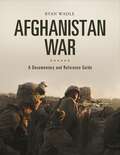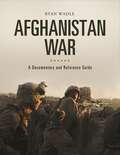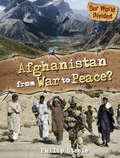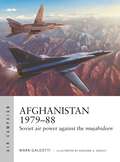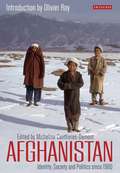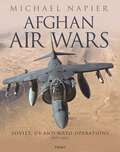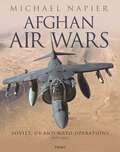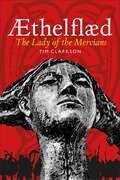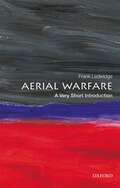- Table View
- List View
Afghanistan War: A Documentary and Reference Guide (Documentary and Reference Guides)
by Ryan WadleProviding an invaluable introductory resource for students investigating the war in Afghanistan, this book highlights the evolution of the conflict through the documents that helped to shape it.This carefully curated primary source collection includes more than 80 documents from the national and international participants in nearly four decades of conflict that led to the Afghanistan War. Readers will gain an understanding of the macro and micro costs of the war on the participants and the political, social, economic, and military factors that have allowed the fighting to persist. Authored by a former member of the Afghanistan Study Team at the U.S. Army's Combat Studies Institute, readers will gain special insight into the military dynamics of the war in Afghanistan and how the war has changed those who have fought in it.The book is divided into four chapters that cover the primary phases of the war in Afghanistan: The Soviet Invasion and Civil War, 1979–2001; Operation ENDURING FREEDOM and Reconstruction Begins, 2001–2003; The Taliban Return, 2003–2009; and The Surge, Drawdown, and an Uncertain Future, 2009–2017. This structure enables readers to clearly understand how the war evolved and the most significant developments that shaped each period.
Afghanistan War: A Documentary and Reference Guide (Documentary and Reference Guides)
by Ryan WadleProviding an invaluable introductory resource for students investigating the war in Afghanistan, this book highlights the evolution of the conflict through the documents that helped to shape it.This carefully curated primary source collection includes more than 80 documents from the national and international participants in nearly four decades of conflict that led to the Afghanistan War. Readers will gain an understanding of the macro and micro costs of the war on the participants and the political, social, economic, and military factors that have allowed the fighting to persist. Authored by a former member of the Afghanistan Study Team at the U.S. Army's Combat Studies Institute, readers will gain special insight into the military dynamics of the war in Afghanistan and how the war has changed those who have fought in it.The book is divided into four chapters that cover the primary phases of the war in Afghanistan: The Soviet Invasion and Civil War, 1979–2001; Operation ENDURING FREEDOM and Reconstruction Begins, 2001–2003; The Taliban Return, 2003–2009; and The Surge, Drawdown, and an Uncertain Future, 2009–2017. This structure enables readers to clearly understand how the war evolved and the most significant developments that shaped each period.
Afghanistan, Pakistan and Strategic Change: Adjusting Western regional policy (Asian Security Studies)
by Joachim Krause Charles King MalloryThe region encompassing Afghanistan and Pakistan (Af/Pak region) is undergoing a fundamental strategic change. This book analyses the nature of this strategic change, in ordre to seek possible future scenarios and to examine policy options. It also undertakes a critical review of the basic elements of the Western strategic approach towards dealing with regional conflicts in all parts of the world, with special emphasis on the Af/Pak region.Dealing with the political developments i one of the most volatile regions in the world – Afghanistan and Pakistan – the volume focuses on Western strategic concerns. The withdrawal of ISAF by 2014 will change the overall political setting and the work addresses the challenges that will result for Western policymakers thereafter. It examines the cases of Afghanistan and Pakistan separately, and also looks at the broader region and tries to identify different outcomes. This book will be of much interest to students of Central and South Asian politics, strategic studies, foreign policy and security studies generally.
Afghanistan, Pakistan and Strategic Change: Adjusting Western regional policy (Asian Security Studies)
by Joachim Krause Charles King Mallory IvThe region encompassing Afghanistan and Pakistan (Af/Pak region) is undergoing a fundamental strategic change. This book analyses the nature of this strategic change, in ordre to seek possible future scenarios and to examine policy options. It also undertakes a critical review of the basic elements of the Western strategic approach towards dealing with regional conflicts in all parts of the world, with special emphasis on the Af/Pak region.Dealing with the political developments i one of the most volatile regions in the world – Afghanistan and Pakistan – the volume focuses on Western strategic concerns. The withdrawal of ISAF by 2014 will change the overall political setting and the work addresses the challenges that will result for Western policymakers thereafter. It examines the cases of Afghanistan and Pakistan separately, and also looks at the broader region and tries to identify different outcomes. This book will be of much interest to students of Central and South Asian politics, strategic studies, foreign policy and security studies generally.
Afghanistan From War to Peace: Afghanistan From War To Peace (Our World Divided)
by Philip SteeleThe background, history and key events of conflicts in Afghanistan are presented. Different opinions, including views found in the media, are explored alongside factual accounts of events. Readers are encouraged to think about their own views and discuss controversial topics.
Afghanistan Cave Complexes 1979–2004: Mountain strongholds of the Mujahideen, Taliban & Al Qaeda (Fortress #26)
by Mir Bahmanyar Mr Ian PalmerFollowing the Soviet invasion in 1979, the Mujahideen defenders of Afghanistan developed and reinforced many natural cave systems to use as supply bases and defensive positions. The Taliban and Al Qaeda further strengthened these positions in the 1990s. Following the events of September 11, 2001, these cave systems have once more come to prominence and sites such as Tora Bora and Zhawar Kili have featured in news headlines around the world. This title provides an analysis of these caves and underground systems, and discusses the U.S.-led Coalition's tactical approach to dislodging the enemy from these fortified positions.
Afghanistan Cave Complexes 1979–2004: Mountain strongholds of the Mujahideen, Taliban & Al Qaeda (Fortress)
by Ian Palmer Mir BahmanyarFollowing the Soviet invasion in 1979, the Mujahideen defenders of Afghanistan developed and reinforced many natural cave systems to use as supply bases and defensive positions. The Taliban and Al Qaeda further strengthened these positions in the 1990s. Following the events of September 11, 2001, these cave systems have once more come to prominence and sites such as Tora Bora and Zhawar Kili have featured in news headlines around the world. This title provides an analysis of these caves and underground systems, and discusses the U.S.-led Coalition's tactical approach to dislodging the enemy from these fortified positions.
Afghanistan at War: From the 18th-Century Durrani Dynasty to the 21st Century
by Tom LansfordCovering wars and conflicts of Afghanistan from the modern founding of the country in the 1700s to the contemporary struggle with the Taliban, this single-volume reference analyzes the causes and results of Afghanistan's wars and examines leading political and military figures, weapons, and tactics.Afghanistan has been embroiled in war and conflict throughout the latter part of the 20th century as well as the current millennium, but due to its location at the crossroads of Central Asia, Afghanistan has also endured repeated conquests throughout its turbulent earlier times. Examining Afghanistan's long military history through this book will enable readers to grasp the wider sociopolitical history of the country; appreciate the impact of these wars on Southwest Asia and superpowers such as Great Britain, the Soviet Union, and the United States; and understand why Afghanistan remains a controversial battleground today.The alphabetically organized entries examine the major wars and conflicts of Afghanistan from the modern founding of the country during the Durrani Dynasty in the 1700s through the contemporary struggle with the Taliban. The book spotlights the role of key individuals in starting, pursuing, or ending conflicts, as well as their broader contributions to—or negative impact on—Afghanistan and the international arena. The work also presents essays that examine key subtopics such as weapons, tactics, ethnic groups, religion, and foreign relations. This allows the reader—whether a student, scholar, or member of a nonacademic audience—to examine a topic in depth and see how the event, figure, or movement fits into the broader history of Afghanistan.
Afghanistan at War: From the 18th-Century Durrani Dynasty to the 21st Century
by Tom LansfordCovering wars and conflicts of Afghanistan from the modern founding of the country in the 1700s to the contemporary struggle with the Taliban, this single-volume reference analyzes the causes and results of Afghanistan's wars and examines leading political and military figures, weapons, and tactics.Afghanistan has been embroiled in war and conflict throughout the latter part of the 20th century as well as the current millennium, but due to its location at the crossroads of Central Asia, Afghanistan has also endured repeated conquests throughout its turbulent earlier times. Examining Afghanistan's long military history through this book will enable readers to grasp the wider sociopolitical history of the country; appreciate the impact of these wars on Southwest Asia and superpowers such as Great Britain, the Soviet Union, and the United States; and understand why Afghanistan remains a controversial battleground today.The alphabetically organized entries examine the major wars and conflicts of Afghanistan from the modern founding of the country during the Durrani Dynasty in the 1700s through the contemporary struggle with the Taliban. The book spotlights the role of key individuals in starting, pursuing, or ending conflicts, as well as their broader contributions to—or negative impact on—Afghanistan and the international arena. The work also presents essays that examine key subtopics such as weapons, tactics, ethnic groups, religion, and foreign relations. This allows the reader—whether a student, scholar, or member of a nonacademic audience—to examine a topic in depth and see how the event, figure, or movement fits into the broader history of Afghanistan.
Afghanistan 1979–88: Soviet air power against the mujahideen (Air Campaign)
by Mark GaleottiThe first English-language book to examine the crucial part air power played in the Soviet-Afghan War.The Soviet Union's invasion of Afghanistan was fought as much in the air as on the ground. From the high-level bombing raids that blasted rebel-held mountain valleys, to the Mi-24 helicopter gunships and Su-25 jets that accompanied every substantial army operation, Soviet control of the air was a crucial battlefield asset. Vital to every aspect of its operations, Mi-8 helicopters ferried supplies to remote mountain-top observation points and took the bodies of fallen soldiers on their last journey home in An12 'Black Tulips'. But this was not a wholly one-sided conflict. Even before the Afghan rebels began to acquire man-portable surface-to-air missiles such as the controversial US 'Stinger,' they aggressively and imaginatively adapted. They learnt new techniques of camouflage and deception, set up ambushes against low-level attacks, and even launched daring raids on airbases to destroy aircraft on the ground.Featuring information previously unknown in the West, such as the Soviets' combat-testing of Yak-38 'Forger' naval jump jets, Soviet-expert Mark Galeotti examines the rebel, Kabul government and the Soviet operation in Afghanistan, drawing deeply on Western and Russian sources, and including after-action analyses from the Soviet military. Using maps, battlescenes and detailed 'Bird's Eye Views', he paints a comprehensive picture of the air war and describes how, arguably, it was Soviet air power that made the difference between defeat for Moscow and the subsequent stalemate that they decided to disengage from.
Afghanistan 1979–88: Soviet air power against the mujahideen (Air Campaign #35)
by Mark GaleottiThe first English-language book to examine the crucial part air power played in the Soviet-Afghan War.The Soviet Union's invasion of Afghanistan was fought as much in the air as on the ground. From the high-level bombing raids that blasted rebel-held mountain valleys, to the Mi-24 helicopter gunships and Su-25 jets that accompanied every substantial army operation, Soviet control of the air was a crucial battlefield asset. Vital to every aspect of its operations, Mi-8 helicopters ferried supplies to remote mountain-top observation points and took the bodies of fallen soldiers on their last journey home in An12 'Black Tulips'. But this was not a wholly one-sided conflict. Even before the Afghan rebels began to acquire man-portable surface-to-air missiles such as the controversial US 'Stinger,' they aggressively and imaginatively adapted. They learnt new techniques of camouflage and deception, set up ambushes against low-level attacks, and even launched daring raids on airbases to destroy aircraft on the ground.Featuring information previously unknown in the West, such as the Soviets' combat-testing of Yak-38 'Forger' naval jump jets, Soviet-expert Mark Galeotti examines the rebel, Kabul government and the Soviet operation in Afghanistan, drawing deeply on Western and Russian sources, and including after-action analyses from the Soviet military. Using maps, battlescenes and detailed 'Bird's Eye Views', he paints a comprehensive picture of the air war and describes how, arguably, it was Soviet air power that made the difference between defeat for Moscow and the subsequent stalemate that they decided to disengage from.
Afghanistan: The Soviet Union's Last War
by Mark GaleottiThe Soviet Union's last war was played out against the backdrop of dramatic change within the USSR. This is the first book to study the impact of the war on Russian politics and society. Based on extensive use of Soviet official and unofficial sources, as well as work with Afghan veterans, it illustrates the way the war fed into a wide range of other processes, from the rise of grassroots political activism to the retreat from globalism in foreign policy.
Afghanistan: The Soviet Union's Last War
by Mark GaleottiThe Soviet Union's last war was played out against the backdrop of dramatic change within the USSR. This is the first book to study the impact of the war on Russian politics and society. Based on extensive use of Soviet official and unofficial sources, as well as work with Afghan veterans, it illustrates the way the war fed into a wide range of other processes, from the rise of grassroots political activism to the retreat from globalism in foreign policy.
Afghanistan: Aid, Armies and Empires (Library of Modern Middle East Studies)
by Peter MarsdenAs the battle for Afghanistan intensifies, with the NATO-led coalition seemingly unable to defeat the Taliban, and struggling in its nation building efforts, Afghanistan expert Peter Marsden looks at why it is that the Great Powers, from 19th-century Britain to the 20th-century Soviet Union to 21st-century America, have so often been frustrated in attempting to impose their will on this strategically vital country. In comparing the three interventions, Marsden uncovers a number of similarities. The rhetoric of 'development' coming from the capitals of the West has, he finds, a well-established heritage. Every would-be occupier has used some form of aid to try and turn Afghanistan into the kind of country that would suit their geopolitical objectives. Marsden, who has worked with British NGOs in Afghanistan for 20 years, draws on his own experience as well as extensive archive research to establish how these grand interventions appear from the Afghan perspective, and why it is that ordinary Afghans seem to be better off when they are attracting less, not more, attention from the world powers. He argues that the Americans have yet to learn the lessons that the Soviets and the British before them learned: that no amount of financial, military or humanitarian aid will 'stabilise' the country if it comes with violence and foreign occupation. Afghanistan - Aid, Armies and Empires offers both an exploration of the relationship between aid and power, and a fresh and original history of Afghanistan through the prism of great power politics.
Afghanistan: Identity, Society and Politics Since 1980 (Library of Modern Middle East Studies #20150213)
by Roy Olivier Micheline Centlivres-DemontOver the last three decades Afghanistan has been plagued by crisis from Soviet invasion in 1979 and Taliban rule to US invasion following the events of 9/11. Here the top specialists on Afghanistan, including Olivier Roy, Ahmad Rashid and Jonathan Goodhand, provide a unique overview of the evolution, causes and future of the Afghan crisis. While much has been written about the problems in Afghanistan, this book also explores the unprecedented transformation of Afghan society, paying close attention to the country's cultural heritage. With varied perspectives from the fields of politics, history, science, economics, anthropology, musicology, art history and architecture, Centlivres-Demont sheds new light on the development and perception of Afghanistan over the past 30 years. Covering political and military events and examining the role of ethnic groups, religious and ideological factors and the role of the leaders and war chiefs of the period from the anti-Soviet resistance to the presidency of Hamid Karzai this book will prove essential reading to all interested in Afghanistan and the wider Middle East region. Examining recent events in the light of the country's economy, Afghan civil society and state reconstruction attempts, this is a comprehensive and diverse look at a country whose recent history has been marked by internal conflicts and foreign intervention.
The Afghan Papers: Committing Britain to War in Helmand, 2005–06 (Whitehall Papers)
by Michael ClarkeIn 2006, British forces entered the Helmand Province of Afghanistan in what would become one of the defining military campaigns of the decade. At great cost in blood and treasure, the UK waged a protracted counter-insurgency against a resurgent Taliban. But how was the decision taken to commit Britain to such a difficult and drawn out campaign? The Afghan Papers is the result of private interviews with and frank contributions by some of the most important actors in the fateful decision. Former generals, politicians and civil servants contribute to an original RUSI analysis that provides a startling insight into the decision to commit the UK to a war – a decision wracked by conflict, incoherence and confusion.
The Afghan Papers: Committing Britain to War in Helmand, 2005–06 (Whitehall Papers)
by Michael ClarkeIn 2006, British forces entered the Helmand Province of Afghanistan in what would become one of the defining military campaigns of the decade. At great cost in blood and treasure, the UK waged a protracted counter-insurgency against a resurgent Taliban. But how was the decision taken to commit Britain to such a difficult and drawn out campaign? The Afghan Papers is the result of private interviews with and frank contributions by some of the most important actors in the fateful decision. Former generals, politicians and civil servants contribute to an original RUSI analysis that provides a startling insight into the decision to commit the UK to a war – a decision wracked by conflict, incoherence and confusion.
Afghan Crucible: The Soviet Invasion and the Making of Modern Afghanistan
by Elisabeth LeakeA new global history of the Soviet invasion of Afghanistan - an invasion whose consequences are still felt in Afghanistan and across the wider world. On 24 December 1979, Soviet armed forces entered Afghanistan, beginning an occupation that would last almost a decade and creating a political crisis that shook the world. To many observers, the Soviet invasion showed the lengths to which one of the world's superpowers would go to vie for supremacy in the global Cold War. The Soviet war, and parallel covert American aid to Afghan resistance fighters, would come to be a defining event of international politics in the final years of the Cold War, lingering far beyond the Soviet Union's own demise. Yet Cold War competition is only a small part of the story. Soviet troops entered a country already at war with itself. A century of debates within Afghanistan over the nature of modern nationhood culminated in a 1978 coup in which self-described Afghan communists pledged to fundamentally reshape Afghanistan. Instead what broke out was a civil war in which Afghans asserted competing models of Afghan statehood. Afghan socialists and Islamists came to the fore of this conflict in the 1980s, thanks in part to Soviet and American involvement, but they represented a broader movement for local articulations of social and political modernity that did not derive from foreign models. Afghans, in conversation with foreigners, set many of the parameters of the conflict. This sweeping history moves between centres of state in Kabul, Moscow, Islamabad, and Washington, the halls of global governance in Geneva and New York, resistance hubs in Peshawar and Panjshir, and refugee camps scattered across Pakistan's borderlands to tell a story that is much more expansive than the Soviet invasion of Afghanistan - a global history of a moment of crisis not just for Afghanistan or the Cold War but international relations and the postcolonial state.
Afghan Crucible: The Soviet Invasion and the Making of Modern Afghanistan
by Elisabeth LeakeA new global history of the Soviet invasion of Afghanistan - an invasion whose consequences are still felt in Afghanistan and across the wider world. On 24 December 1979, Soviet armed forces entered Afghanistan, beginning an occupation that would last almost a decade and creating a political crisis that shook the world. To many observers, the Soviet invasion showed the lengths to which one of the world's superpowers would go to vie for supremacy in the global Cold War. The Soviet war, and parallel covert American aid to Afghan resistance fighters, would come to be a defining event of international politics in the final years of the Cold War, lingering far beyond the Soviet Union's own demise. Yet Cold War competition is only a small part of the story. Soviet troops entered a country already at war with itself. A century of debates within Afghanistan over the nature of modern nationhood culminated in a 1978 coup in which self-described Afghan communists pledged to fundamentally reshape Afghanistan. Instead what broke out was a civil war in which Afghans asserted competing models of Afghan statehood. Afghan socialists and Islamists came to the fore of this conflict in the 1980s, thanks in part to Soviet and American involvement, but they represented a broader movement for local articulations of social and political modernity that did not derive from foreign models. Afghans, in conversation with foreigners, set many of the parameters of the conflict. This sweeping history moves between centres of state in Kabul, Moscow, Islamabad, and Washington, the halls of global governance in Geneva and New York, resistance hubs in Peshawar and Panjshir, and refugee camps scattered across Pakistan's borderlands to tell a story that is much more expansive than the Soviet invasion of Afghanistan - a global history of a moment of crisis not just for Afghanistan or the Cold War but international relations and the postcolonial state.
Afghan Air Wars: Soviet, US and NATO operations, 1979–2021
by Michael NapierMichael Napier details the critical role of air power in the skies over Afghanistan, from the ten-year occupation by the USSR in the 1980s through to the US and NATO campaign from 2001 to 2021.US and British forces, strongly supported by air power, invaded Afghanistan in late 2001 in response to the Al Qaida attacks on 9/11. What began as a small-scale operation of 2,500 troops with the limited objective of destroying Al Qaida became ever larger, growing to over 100,000 troops ten years later. This experience matched that of the Soviets after their invasion in late 1979, when they saw a massive increase in resistance by Mujahidin. Afghan Air Wars details how Soviet aircraft including the MiG-21, MiG-23, Su-17 and Su-25, as well as Mi-8 and Mi-24 helicopters supported Soviet offensives in the Panjshir Valley and other regions. Despite these high-octane operations and overwhelming air superiority, Soviet forces eventually withdrew. Some 20 years later, US and NATO air forces were deployed in similar roles. F-15E, F-16, F/A-18, A-10, Mirage, Harrier and Tornado aircraft all saw action in the skies over Afghanistan as did the CH-47 Chinook and AH-64 Apache helicopters. Mike Napier fully details their series of operations in a hostile environment as well as the advent of high-resolution targeting pods and Precision Guided Munitions (PGM) which enabled aircraft to stand off from threat areas and also to deploy their weapons with deadly accuracy. The conflict also saw the groundbreaking introduction of Remotely Piloted Vehicles (RPV) into routine air operations. Afghan Air Wars is richly illustrated with over 240 images – both official photos and privately taken, in-theatre images which have not been previously published. It also includes first-hand accounts by aircrews involved to create a unique and comprehensive picture of the part played by air power over Afghanistan in the last 40 years.
Afghan Air Wars: Soviet, US and NATO operations, 1979–2021
by Michael NapierMichael Napier details the critical role of air power in the skies over Afghanistan, from the ten-year occupation by the USSR in the 1980s through to the US and NATO campaign from 2001 to 2021.US and British forces, strongly supported by air power, invaded Afghanistan in late 2001 in response to the Al Qaida attacks on 9/11. What began as a small-scale operation of 2,500 troops with the limited objective of destroying Al Qaida became ever larger, growing to over 100,000 troops ten years later. This experience matched that of the Soviets after their invasion in late 1979, when they saw a massive increase in resistance by Mujahidin. Afghan Air Wars details how Soviet aircraft including the MiG-21, MiG-23, Su-17 and Su-25, as well as Mi-8 and Mi-24 helicopters supported Soviet offensives in the Panjshir Valley and other regions. Despite these high-octane operations and overwhelming air superiority, Soviet forces eventually withdrew. Some 20 years later, US and NATO air forces were deployed in similar roles. F-15E, F-16, F/A-18, A-10, Mirage, Harrier and Tornado aircraft all saw action in the skies over Afghanistan as did the CH-47 Chinook and AH-64 Apache helicopters. Mike Napier fully details their series of operations in a hostile environment as well as the advent of high-resolution targeting pods and Precision Guided Munitions (PGM) which enabled aircraft to stand off from threat areas and also to deploy their weapons with deadly accuracy. The conflict also saw the groundbreaking introduction of Remotely Piloted Vehicles (RPV) into routine air operations. Afghan Air Wars is richly illustrated with over 240 images – both official photos and privately taken, in-theatre images which have not been previously published. It also includes first-hand accounts by aircrews involved to create a unique and comprehensive picture of the part played by air power over Afghanistan in the last 40 years.
Aethelflaed: The Lady of the Mercians
by Tim ClarksonAt the end of the ninth century AD, a large part of what is now England was controlled by the Vikings – heathen warriors from Scandinavia who had been attacking the British Isles for more than a hundred years. Alfred the Great, king of Wessex, was determined to regain the conquered lands but his death in 899 meant that the task passed to his son Edward. In the early 900s, Edward led a great fightback against the Viking armies. He was assisted by the English rulers of Mercia: Lord Æthelred and his wife Æthelflæd (Edward’s sister).After her husband’s death, Æthelflæd ruled Mercia on her own, leading the army to war and working with her brother to achieve their father’s aims. Known to history as the Lady of the Mercians, she earned a reputation as a competent general and was feared by her enemies. She helped to save England from the Vikings and is one of the most famous women of the Dark Ages. This book, published 1100 years after her death, tells her remarkable story.
Aeroplane (UEB Uncontracted)
by RnibThis is an image of an aeroplane viewed from above. There is a locator dot shown, which will be at the top left of the page when the image is the right way up. The front (nose) of the aeroplane is at the left of the page, and the back (tail) on the right. The cockpit, where the pilot sits, is near the nose of the aeroplane. To the right of this is the long main cabin for the passengers. On each side of the passenger cabin there is a long wing. Each wing has an engine on the front, and flaps to control the aeroplane at the rear. The smaller wings making up the tail also have flaps at the rear.
Aeroplane (UEB Contracted)
by RnibThis is an image of an aeroplane viewed from above. There is a locator dot shown, which will be at the top left of the page when the image is the right way up. The front (nose) of the aeroplane is at the left of the page, and the back (tail) on the right. The cockpit, where the pilot sits, is near the nose of the aeroplane. To the right of this is the long main cabin for the passengers. On each side of the passenger cabin there is a long wing. Each wing has an engine on the front, and flaps to control the aeroplane at the rear. The smaller wings making up the tail also have flaps at the rear.
Aerial Warfare: A Very Short Introduction (Very Short Introductions)
by Frank LedwidgeAerial warfare has dominated war-making for over 100 years, and despite regular announcements of its demise, it shows no sign of becoming obsolete. In this Very Short Introduction Frank Ledwidge offers a sweeping look at the history of aerial warfare, introducing the major battles, crises, and controversies where air power has taken centre stage, and the changes in technology and air power capabilities over time. Highlighting the role played by air power in the First and Second World Wars, he also sheds light on the lesser-known theatres where the roles of air forces have been clearly decisive in conflicts, in Africa, South America, and Asia. Along the way, Ledwidge asks key questions about the roles air power can deliver, and whether it is conceptually different from other forms of combat. Considering whether bombing has ever been truly effective, he discusses whether wars can be won from the air, and concludes by analysing whether there is a future for manned air power, or if it is inevitable that drones will dominate 21st century war in the air. ABOUT THE SERIES: The Very Short Introductions series from Oxford University Press contains hundreds of titles in almost every subject area. These pocket-sized books are the perfect way to get ahead in a new subject quickly. Our expert authors combine facts, analysis, perspective, new ideas, and enthusiasm to make interesting and challenging topics highly readable. Previously published in hardback as Aerial Warfare: The Battle for the Skies.
